event
KAIST will showcase the ten most cutting-edge technologies developed by KAIST faculty and researchers at the 2017 KAIST Tech Fair. The fair will be held on September 12 at the COEX in Seoul. The fair will bring companies, venture capitalists, and tech consultants from around the country to learn about the most commercially potential technology from KAIST.
The ten technologies, all already patented, will be highly relevant for the new industrial trends summed up by the Fourth Industrial Revolution. They include the fields of ICT, unmanned transportation, AI, robotics, IoT, nano, and big data.
The Technology Evaluation Committee, comprised of the heads of the departments at KAIST, patent lawyers, and venture capitalists, selected the ten technologies based on their applicability, innovativeness, and marketability. The selectees will be provided with various commercialization support and services including the manufacturing of prototypes, marketing consultation at home and abroad, as well as handling IPR issues, among others.
KAIST will hold an information session as well as consultations for successful technology commercialization as one of the innovative plans proposed by the KAIST President Sung-Chul Shin. This session will invite 200 entrepreneurs who are interested in the selected technologies.
Associate Vice President of University-Industry Cooperation Kyung Cheol Choi said, “Starting with the selection of 2017 top ten crucial technologies, KAIST will continue supporting technology marketing as well as its successful transfer. KAIST will make effort to carry out university-industry cooperation and find core patent technologies and project ideas in order to stimulate technology commercialization.”
The list of the ten critical patent technologies selected by KAIST is as follows:
▶ Catalyst-Decorated Nanofiber Sensor for Health Monitoring
By Professor Il-Doo Kim (Department of Materials Science and Engineering)
Human breath carries diverse components of diseases such as asthma, lung cancer, type 1 diabetes mellitus, and halitosis. Thus, it is possible to analyze exhaled breath very rapidly with a simple analyzing process and it can detect trace changes in exhaled breath components, which trigger diseases.
The research team developed highly sensitive and selective chemical gas sensors that can detect specific disease, using protein-encapsulated nanocatalysts. They can diagnose certain diseases by analyzing human exhaled breath. This technology enables the early monitoring of various diseases through pattern recognition of biomarker gases associated with the diseases in human exhalation.
The established sensing libraries can detect biomarker species with high sensitivity and selectivity. The team hopes that the new and innovative breath gas analysis platform will be very helpful for reducing medical expenditures and the continuous monitoring of physical conditions.
# Detection of environmental toxic gases, monitoring of body health condition
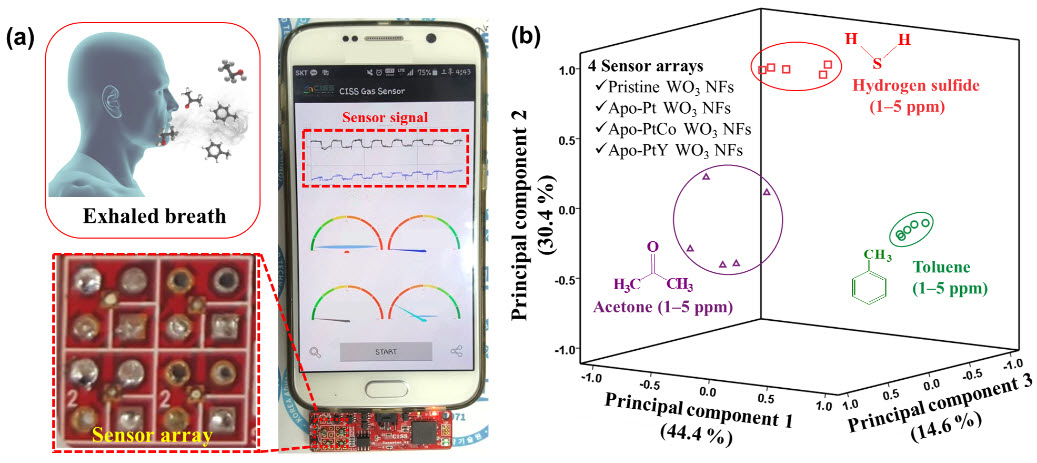
Figure (a) Mobile device integrated with nanofiber based MEMS sensors
Figure (b) Exhaled breath pattern recognition: principle component analysis for the accurate detection of acetone, hydrogen sulfide, and toluene gases
▶ Technology for a Cancer Cure Using Big Data and Simulating Biological Network
By Professor Kwang-Hyun Cho (Department of Bio and Brain Engineering)
The complex and heterogeneous nature of cancer, which results in highly variable drug responses, is a major obstacle in curing cancer. Previous methods to predict drug responses mostly focus on the static analysis of genome-wide alternations, resulting in a limitation for the understanding of cancer heterogeneity and its variable responses.
The research team used a method to integrate cancer genomics data with the dynamics of biological networks for drug response prediction and to design of effective drug combination. It provides a computational framework for evaluating drug efficacies and synergistic effects by combining the attractor landscape analysis of a biological network with the genomic alteration profiles of cancer cells.
This technology can reduce the cost of drug development by predicting drug responses and help selecting more effective new drug targets in consideration of the overall cellular response landscape. It can also provide comprehensive insight into the mechanistic origin of variable drug responses. The patent technology can be applicable to designing more effective and cancer-specific combination therapies.
# Development of targeted anticancer drugs, genetic testing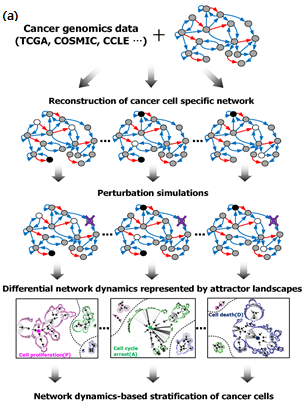
Figure (a) The computational prediction of drug responses using attractor landscape analysis of network dynamics
▶ Highly Stretchable, Wearable Strain Sensor
By Professor O Ok Park (Department of Chemical and Biomolecular Engineering)
Conventional materials for strain sensor are metals or semiconductors, but these materials show a limited range of strain. To improve the stretchability of conventional materials, several projects have been done using novel materials with a high aspect ratio; nevertheless, these projects encountered problems, including complex and expensive processes, poor scalable features, and low controllability of the sensitivity in the manufacturing step.
The research team used a layer-by-layer assembly technique to control the sensitivity of the sensor in a facile and inexpensive method. By using stretchable yarn as a substrate, the graphene strain sensor gained more stretchability.
Through the newly-patented technology, the graphene strain sensor can be fabricated using an all-solution process; therefore, the sensitivity of the sensor can be easily controlled with a repetitive cycle of the coating process. The size of this sensor can be controlled as well, because it depends only on the size of coated substrate.
# Wearable strain sensor, planar strain sensor 
Figure (a) Nylon-covered rubber yarn showing linear relationship between the applied strain load and its resistance change
Figure (b) Wool yarn showing an inverse relation of resistance with the applied strain load
▶ Chip & Flash Memory Data Security Device
By Professor Yang-Kyu Choi (School of Electrical Engineering)
Using software-based security methods can lead to having problems related to the backtracking of a security function through reverse engineering, the replication of an input value, and the forgery and modification of software. These problems should not be neglected, especially as people are increasingly recognizing the importance of personal information.
To meet the growing demands for new security methods for constructing a more perfect security system, the research team developed a hardware-based security device as well as methods for a higher level of security in the era of IoTs. The principles of the technologies are based on nanotechnology, such as mechanical deformation in a nanowire, electrical degradation in a field-effect transistor (FET), and thermal data erasing stored in the charge trap layer in flash memory. Hence, the security states are extremely safe, compared with software-based security methods and cannot be reverse-engineered by unauthorized users.
This patented technology can be used to improve the security level of logic circuits and flash memory against unauthorized users.
# Financial businesses, the defense industry, private electronics including smartphones, tablets and PCs, electronics for missions in extreme environments

Figure (a) Application for a high level of security in a logic circuit
▶ A Bio-Healthcare Device for Neuroimaging
By Professor Hyeonmin Bae (School of Electrical Engineering)
There are no portable brain imaging devices and, as a result, brain diseases are often diagnosed after irreversible symptoms appeared. This can also be linked to an increase in social expenditures as a society ages.
A near-infrared spectroscopy neuroimaging device for functional brain imaging, NIRSIT, utilizes light to detect hemodynamic changes in cerebral blood flow and visualizes brain activation regions in the prefrontal area of the brain in real time.
Unlike any other existing brain imaging devices (i.e. fMRI and conventional fNIRS), NIRSIT has improved its spatial resolution while maintaining complete portability.
Furthermore, NIRSIT is probably the one and only portable and wireless NIRS device, designed to be used for brain research and clinical purposes. A software application allows the raw data extracted from the hemodynamic changes in the brain to be shown in real time on a tablet wirelessly connected to NIRSIT.
Thanks to its easy-to-use features and user-friendly design, both in hardware and in software, NIRSIT will surely set a new paradigm in the brain research and healthcare fields.
# Concussion analysis, wearable stroke monitoring, CPR monitoring, Alzheimer’s disease, neuro rehabilitation, determination of brain death
Figure (a) Image of NIRSIT, Figure (b) Neuroimaging using NIRSIT
▶ Technology for Virtual Creatures with Digitally-Emotional DNA of Users
By Professor Jong-Hwan Kim (School of Electrical Engineering)
Currently, a large number of IT companies around the world are trying to develop a system that can offer active and emotional services and the interface method is one of the most important issues.
Although most of the existing software agents are equipped with virtual faces and voices, they do not possess a personality similar to humans. Having various personalities, like human beings, can be a charming point for users, which then leads them to have higher satisfaction with the product.
Dr. Kim’s research team developed Darwin C (Digital Agent Reconstruction with Intelligence and Natural Character), a digital agent software that provides an optimized emotional service based on personal big data, such as the user’s conversations, locations, photos, music, etc., collected from smart devices.
With this technology, the digital DNAs of a user (i.e. appearance, voice, and personality DNA) is extracted from personal data stored on various smart devices. Based on the extracted digital DNA, a 3-D software agent can be formed in a smartphone, which characterizes an individual that the user hopes to meet, such as parents, spouse, grandchild, or a celebrity.
The software agents will be expanded from Android devices to home appliances. The team expected that this technology can help customers who want to understand more about a friend or form and maintain interpersonal relations.
# Entertainment, hardware robots for education, healthcare curing depression and loneliness
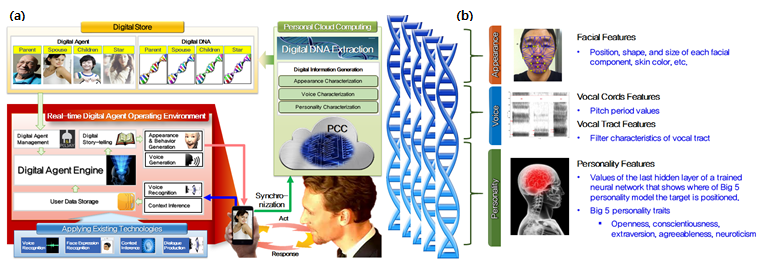
Figure (a) Overview of the DarwinC technology, Figure (b) Structure of digital DNA
▶ Laser-Integrated Precision Metrological System Technology for Smart Factories
By Professor Seung-woo Kim (Department of Mechanical Engineering)
In optical distance metrology, the time-of-flight method of using light pulses permits measuring distances over extensive ranges. However, the measurement precision reaches just a few tens of millimeters at most, mainly because the responsivity of the photodetectors available today is limited to the picosecond range. In addition, one device can measure only one target. For these reasons, a novel technology was devised to overcome the traditional limits of time-of-flight measurement.
This patented technology uses a highly precise, laser-integrated distance measurement system for diagnosing large machines and smart factories. This technology was devised to handle the status (e.g. position, 3-D coordinate, and thermal deformation) of multiple targets simultaneously. It is called the multi-target distance meter (MDM) and was constructed by combining a nonlinear optical crystal with a pair of femtosecond lasers.
This technology is able to measure the distances to multiple targets with a single piece of equipment, and it can easily extend the number of targets by just adding beam-splitting devices. Not only does the technology help by reducing cost and complexity, it also enables real-time quality control in the manufacturing industry.
# Real-time on-axis position inspection of a multiple-lens assembly, long-term thermal displacement monitoring of a large, precise machine, 3-D motion control of a mobile vehicle
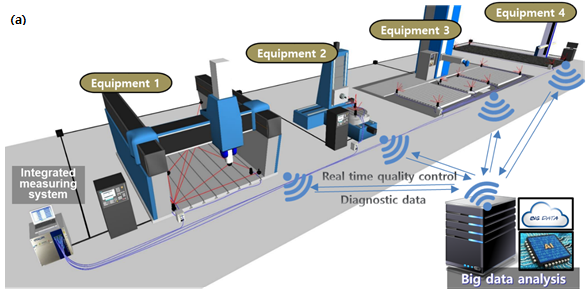
Figure (a) Conceptual image of smart factory monitoring using laser-integrated precision metrological system technology
▶ SLAM Technology for Autonomous Robot Navigation in a Dynamic Indoor/Outdoor Environment
By Professor Hyun Myung (Department of Civil & Environmental Engineering)
Dr. Myung’s research team developed SLAM (Simultaneous Localization and Mapping) technology for autonomous robot navigation in dynamic indoor/outdoor environments. Two methods were applied to this technology: a hierarchical graph structure-based 3-D high resolution map building method using a low-cost 2D laser scanner and a magnetic field-based localization method for feature-poor environments.
Existing technology required expensive sensors for outdoor environment. The localization and mapping technique were also not very accurate, especially in dynamic environments. The team wanted to provide robust SLAM in low and high dynamic object environments using the fusion of low-cost sensors, such as magnetics, 2-D LiDAR, and camera sensors.
Through this technology, the accuracy of localization and mapping could be increased to within 10cm, using low-cost sensors. Also, it facilitates localization and mapping even in feature-poor environments.
# Autonomous robot navigation in warehouses, autonomous navigation of self-driving cars, autonomous navigation of AGVs (Automated Guided Vehicles) in smart factories
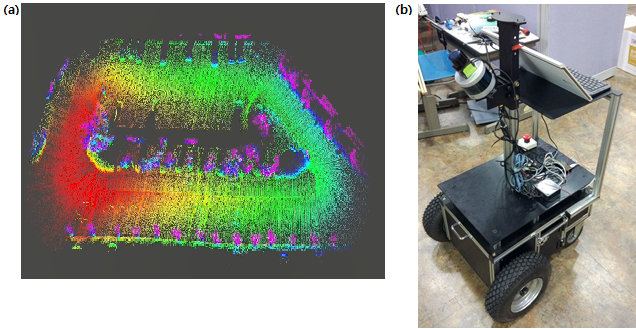
Figure (a) Built outdoor 3-D mappring using a mobile robot with tilted 2-D LiDAR sensor, Figure (b) Mobile robot system for GPS-less mappring
▶ Technology for Optimizing 5G Beamforming IC
By Songcheol Hong (School of Electrical Engineering)
Dr. Hong’s team introduced a new structure for low-power, subminiature, and highly-linear beamforming IC technology. The patent used in this technology reduced the chip size and the direct current (DC) power dissipations drastically, allowing it to make mmWave beamforming antennas.
Beam-forming technology has emerged as an important area in the field of 5G communications and radar systems. It facilitates communication and signal detection with very low RF power.
The patents can be applied to 5G communication beam-forming ICs and antenna modules in mobile terminals, base stations and terminals in the automotive field. Moreover, they can be used in various mmWave radar systems for automobiles, drones, human computer interfaces, and indoor positioning.
# 5G V2X, IoTs, virtual reality
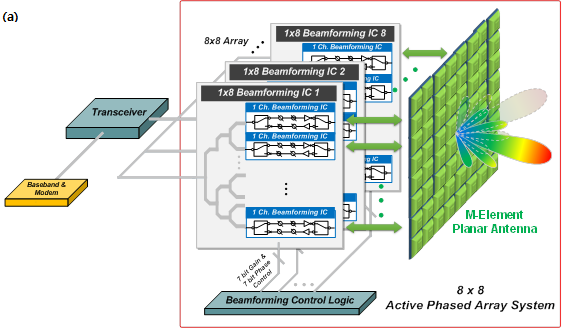
Figure (a) Active phased array system
▶ Beam Division Multiple Access Technology
By Professor Dong Ho Cho (School of Electrical Engineering)
Using a 5G network, a communication infrastructure for supporting high-speed, real-time services requires new technologies that enable 4x4 MIMO transmissions within beam-based wireless systems in a new frequency band and improves spectral efficiency more than ten times compared to LTE in domestic and overseas mobile communication carriers and related industries.
P2BDMA, a pattern or polarization beam division multiple access technology, is a core technology for addressing this demand for 5G networks as it enables 4x4 MIMO transmissions in mmWave frequency bands by utilizing the pattern polarization characteristic of radio waves.
The research team upgraded BDMA technology in which the same frequency resource is reused in more than two spaces by using beamforming. This technology increases the degree of freedom (DOF) of wireless communication channels, and thereby improves the achievable data transmission rate by employing multiple pattern/polarization antennas in the conventional BDMA system. The P2BDMA technique has the advantage of eliminating the frequency shortage problem and increasing the transmission speed while using the wide frequency band in a more efficient manner.
The team expects that this technology will alleviate the frequency shortage problem and CAPEX/OPEX of domestic mobile telecommunication companies, support an increase in sales for related equipment makers to make it internationally competitive, and further play a central role in providing high-speed transmission rates to a large number of IoT devices in the future IoT era.
# Autonomous vehicle, communication infrastructure, mobile access system

Figure (a) Concept of P2BDMA technology
-
research KAIST Develops Sodium Battery Capable of Rapid Charging in Just a Few Seconds
Sodium (Na), which is over 500 times more abundant than lithium (Li), has recently garnered significant attention for its potential in sodium-ion battery technologies. However, existing sodium-ion batteries face fundamental limitations, including lower power output, constrained storage properties, and longer charging times, necessitating the development of next-generation energy storage materials. On the 11th of April, KAIST (represented by President Kwang Hyung Lee) announced that a research t
2024-04-18 -
research KAIST introduces microbial food as a strategy food production of the future
The global food crisis is increasing due to rapid population growth and declining food productivity to climate change. Moreover, today's food production and supply system emit a huge amount of carbon dioxide, reaching 30% of the total amount emitted by humanity, aggravating climate change. Sustainable and nutritious microbial food is attracting attention as a key to overcoming this impasse. KAIST (President Kwang Hyung Lee) announced on April 12th that Research Professor Kyeong Rok Choi of th
2024-04-12 -
research KAIST researchers developed a novel ultra-low power memory for neuromorphic computing
A team of Korean researchers is making headlines by developing a new memory device that can be used to replace existing memory or used in implementing neuromorphic computing for next-generation artificial intelligence hardware for its low processing costs and its ultra-low power consumption. KAIST (President Kwang-Hyung Lee) announced on April 4th that Professor Shinhyun Choi's research team in the School of Electrical Engineering has developed a next-generation phase change memory* device fe
2024-04-04 -
research A KAIST-SNUH Team Devises a Way to Make Mathematical Predictions to find Metabolites Related to Somatic Mutations in Cancers
Cancer is characterized by abnormal metabolic processes different from those of normal cells. Therefore, cancer metabolism has been extensively studied to develop effective diagnosis and treatment strategies. Notable achievements of cancer metabolism studies include the discovery of oncometabolites* and the approval of anticancer drugs by the U.S. Food and Drug Administration (FDA) that target enzymes associated with oncometabolites. Approved anticancer drugs such as ‘Tibsovo (active ingre
2024-03-18 -
research KAIST Develops Healthcare Device Tracking Chronic Diabetic Wounds
A KAIST research team has developed an effective wireless system that monitors the wound healing process by tracking the spatiotemporal temperature changes and heat transfer characteristics of damaged areas such as diabetic wounds. On the 5th of March, KAIST (represented by President Kwang Hyung Lee) announced that the research team led by Professor Kyeongha Kwon from KAIST’s School of Electrical Engineering, in association with Chung-Ang University professor Hanjun Ryu, developed digit
2024-03-11